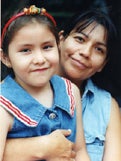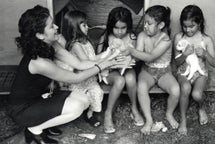
Family Dynamics and the Child with JRA
The key to raising a child with chronic disease is to keep family life as normal as possible. if you have more than one child, treat your child with rheumatic disease exactly the same as you do your other children. He/ she should have the same responsibilities, be subjected to the same discipline and complete the same set of household chores. The most important thing parents can do for their child with rheumatic disease is to raise him/ her exactly as if he did not have a chronic disease.
it is important to separate illness from other aspects of childhood as much as possible. Be patient but firm in your expectations for your child. Don't allow your child to get away with unacceptable behavior just because he is feeling sick or he he/she may use his illness to justify misbehavior. Your child may feel angry or sad about having arthritis. But be aware that you as parents, siblings and other family members also may have emotional reactions about the disease and its effect on the family. Learning how to cope with arthritis will benefit everyone. (15)
Rheumatic disease can lead to social isolation; it's important for school- aged children to participate in after- school activities and sports, with modifications when necessary. Most young children readily take part in normal childhood play groups, but some children are shy or reluctant and may need encouragement from you and the children in the group.
Children learn from experience with acute illnesses like ear infections and stomach aches to expect their symptoms to go away if they follow their parents' and doctor's orders. It is very difficult for children to understand the notion of chronic illness. They will also have trouble understanding that treatment must continue even when they are feeling well. Time, patience and understanding will help since the child who have chronic illness may feel sad, angry, frightened or confused. To help keep things in perspective, the children need to receive honest information about rheumatic illness.
When you are first told your child has arthritis, you might feel shocked or disbelieving. You might also feel guilty and ask yourself if something you did or did not do caused your child's arthritis. While these thoughts are common to parents whose children are ill, you are not to blame. Remember, you are not the cause of your child's arthritis. The child with arthritis may feel many different emotions. Children can feel hurt by an illness that isn't their fault, blame parents for the illness, engage in self-pity, or become angry because of restrictions on activities. They may also resent other children who do not have the disease, including their brothers and sisters. Siblings may feel left out and resentful because of the amount of time and attention the child with arthritis requires. Or they may feel guilty, as if they had somehow caused the illness (15).
Children may over identify with the brother or sister with special needs. Some feel pressure to achieve or make up for what their sibling can no longer do. Others want to involve themselves in care giving to the point that they give up their own normal activities. In these cases, try to help siblings find other ways to deal with their feelings. Let brothers and sisters settle their own differences. Whenever possible, encourage and teach siblings to talk with peers who live in homes with similar concerns.
Although pain sometimes limits physical activity, exercise is important to reduce the symptoms of JRA and maintain function and range of motion of the joints. Most children with JRA can take part fully in physical activities and sports when their symptoms are under control. During a disease flare-up, however, the doctor may advise limiting certain activities depending on the joints involved. Once the flare-up is over, a child can start regular activities again. Swimming is particularly useful because it uses many joints and muscles without putting weight on the joints. A doctor or physical therapist can recommend exercises and activities (11).
Your Child with JRA and Creating a Positive School Environment
The childhood rheumatic disease can make it difficult for children to function at their best in the structured environment of school. There are number of steps you can take to help your child do well in school (13).
-
First, Understand just how illness affects your child's ability to meet the routine demands of the school day.
-
Parents are the child's best advocates. You observe your child's activity in every area of life. By advocating your child's needs in school, you can help create a positive educational experience for him/ her.
-
Parents and school personnel should work together to develop solutions that will allow the child to participate fully in school activities and achieve the best of his/ her ability.
-
All children in the United States are entitled to a free, appropriate public education. Federal and state laws require all public schools to provide support and services that may be needed to help children with disabilities and chronic illnesses benefit from public education. The
Education of the Handicapped Amendments of 1986 deal with educational services for children from birth to 3 years of age. The
Individuals with Disabilities Education Act of 1990 (IDEA) cover educational services for children aged 3 to 21.
-
Good communication among students , parents, school personnel and health care providers is essential to create a rewarding school environment.


